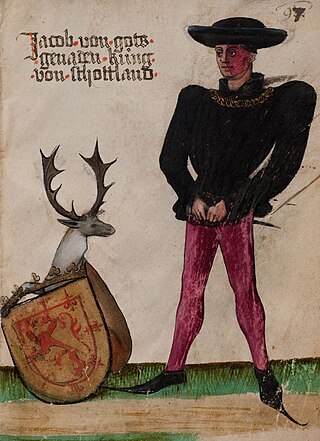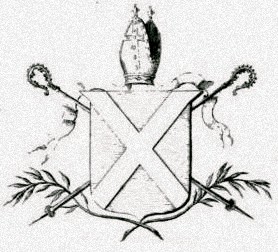Related Research Articles

Holyrood Abbey is a ruined abbey of the Canons Regular in Edinburgh, Scotland. The abbey was founded in 1128 by David I of Scotland. During the 15th century, the abbey guesthouse was developed into a royal residence, and after the Scottish Reformation the Palace of Holyroodhouse was expanded further. The abbey church was used as a parish church until the 17th century, and has been ruined since the 18th century. The remaining walls of the abbey lie adjacent to the palace, at the eastern end of Edinburgh's Royal Mile. The site of the abbey is protected as a scheduled monument.

James II was King of Scots from 1437 until his death in 1460. The eldest surviving son of James I of Scotland, he succeeded to the Scottish throne at the age of six, following the assassination of his father. The first Scottish monarch not to be crowned at Scone, James II's coronation took place at Holyrood Abbey in March 1437. After a reign characterised by struggles to maintain control of his kingdom, he was killed by an exploding cannon at Roxburgh Castle in 1460.
The Bishop of Dunkeld is the ecclesiastical head of the Diocese of Dunkeld, one of the largest and more important of Scotland's 13 medieval bishoprics, whose first recorded bishop is an early 12th-century cleric named Cormac. However, the first known abbot dates to the 10th century, and it is often assumed that in Scotland in the period before the 12th century, the roles of both bishop and abbot were one and the same. The Bishopric of Dunkeld ceased to exist as a Catholic institution after the Scottish Reformation but continued as a royal institution into the 17th century. The diocese was restored by Pope Leo XIII on 4 March 1878; it is now based in the city of Dundee.
The Abbot of Paisley was the head of the Cluniac monastic community of Paisley Abbey and its property. The monastery was founded as a priory at Renfrew in 1163, but moved to Paisley in 1169. It became an abbey in 1219. The founder was Walter fitz Alan, Seneschal (Steward) of Scotland. The line of abbots ended when it was turned into a secular lordship for Lord Claud Hamilton in 1587/1592. The following is a list of abbots and commendators:

The Bishop of St. Andrews was the ecclesiastical head of the Diocese of St Andrews in the Catholic Church and then, from 14 August 1472, as Archbishop of St Andrews, the Archdiocese of St Andrews.
John Scotus was a 12th-century bishop of St. Andrews and Dunkeld.

The Dunkeld Lectern is a mediaeval lectern which was one of the most prized possessions of St Stephen's Church, St Albans, England. The 150 kg brass reading desk stands approximately 1.6 metres high and takes the form of a large eagle with outspread wings, with the bird perched on an orb supported by a turned shaft: an eagle lectern. Engraved on the orb is a Latin inscription Georgius Creichton Episcopus Dunkeldensis.

The Prior, then Abbot and then Commendator of Dunfermline was the head of the Benedictine monastic community of Dunfermline Abbey, Fife, Scotland. The abbey itself was founded in 1128 by King David I of Scotland, but was of earlier origin. King Máel Coluim mac Donnchada had founded a church there with the help of Benedictines from Canterbury. Monks had been sent there in the reign of Étgar mac Maíl Choluim and Anselm had sent a letter requesting that Étgar's brother and successor King Alaxandair mac Maíl Coluim protect these monks. By 1120, when Alaxandair sent a delegation to Canterbury to secure Eadmer for the bishopric of St Andrews, there is a Prior of the Dunfermline monks by the name of Peter leading the delegation. Control of the abbey was secularized in the 16th century and after the accession of James Stewart in 1500, the abbey was held by commendators. In the second half of the 16th century, the abbey's lands were being carved up into lordships and it was finally annexed to the crown in July, 1593.
The Abbot of Holyrood was the head of the Augustinian monastic community of Holyrood Abbey, now in Edinburgh. The long history of the abbey came to a formal end in July 1606 when the parliament of Scotland turned the abbey into a secular lordship for the last commendator, John Bothwell. The following is a list of abbots and commendators:
The Prior of St Mary's Isle was the head of the Augustinian monastic community of St Mary's Isle Priory, in Kirkcudbrightshire, Galloway. The following is a list of priors and commendators:
Clement was a 13th-century Dominican friar who was the first member of the Dominican Order in Britain and Ireland to become a bishop. In 1233, he was selected to lead the ailing diocese of Dunblane in Scotland, and faced a struggle to bring the bishopric of Dunblane to financial viability. This involved many negotiations with the powerful religious institutions and secular authorities which had acquired control of the revenue that would normally have been the entitlement of Clement's bishopric. The negotiations proved difficult, forcing Clement to visit the papal court in Rome. While not achieving all of his aims, Clement succeeded in saving the bishopric from relocation to Inchaffray Abbey. He also regained enough revenue to begin work on the new Dunblane Cathedral.
Donald Campbell was a 16th-century Scottish noble and churchman. He was the son of Archibald Campbell, 2nd Earl of Argyll and Elizabeth Stewart, daughter of John Stewart, 1st Earl of Lennox. From 1522, he was a student of St Salvator's College, at the University of St Andrews. After graduation, he became a cleric in his home diocese, the diocese of Argyll.
Robert Crichton was a 16th-century Scottish Catholic cleric.

George Douglas was a late medieval Scottish nobleman and prelate. He served as Bishop of Moray.
Andrew Durie, bishop of Galloway and abbot of Melrose, was the son of John Durie of Durie in Fife, and brother to George Durie, abbot of Dunfermline and archdeacon of St. Andrews.
Simon de Wedale was a 14th-century Augustinian canon who rose to become Abbot of Holyrood and then Bishop of Galloway. Little is known of Simon until he appears on 27 February 1321 as Abbot of Holyrood Abbey near Edinburgh. His accession to this abbacy had only been recent, since either in January of this year or in January 1320, his predecessor Elias, ruling the abbey since at least 1309 and probably earlier, was still abbot. Abbot Simon occurs again in the records on 10 June 1326.
Henry Wemyss was a prelate from the 16th century Kingdom of Scotland. He appears in the sources in the bishopric of Galloway for the first time in 1517, and rose to become Bishop of Galloway in 1526, a position he held until his death in 1541.
Walter Stewart was a 15th-century churchman in the Kingdom of Scotland. He was a cousin of King James II of Scotland, being like King James a grandson to King Robert III of Scotland.

The Archdiocese of St Andrews was a territorial episcopal jurisdiction of the Catholic Church in early modern and medieval Scotland. It was the largest, most populous and wealthiest diocese of the medieval Scottish Catholic church, with territory in eastern Scotland stretching from Berwickshire and the Anglo-Scottish border to Aberdeenshire.
Thomas Forret, was vicar of Dollar, Clackmannanshire, and a Scottish martyr.